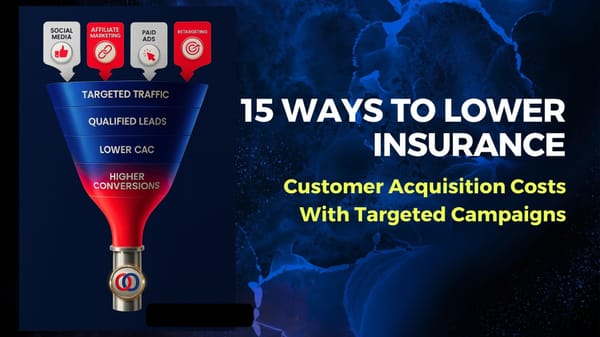Partnership and Affiliate Marketing: Understanding the Affiliate Marketing Ecosystem for Success
A comprehensive guide to understanding the affiliate ecosystem, exploring its components, roles, dynamics, and strategies for success.

Affiliate marketing has become an essential tool in the digital marketing landscape, empowering individuals and businesses to earn revenue through strategic partnerships. But to truly succeed in this competitive arena, it's crucial to understand the mechanics of the affiliate ecosystem. This ecosystem comprises various components and roles that work together to drive performance-based marketing efforts.
In this article, we’ll deeply dive into the affiliate marketing ecosystem, exploring its key players, their roles, their interactions, and strategies for thriving within this system.
What is the Affiliate Ecosystem?
The affiliate ecosystem refers to the interconnected network of individuals, platforms, and businesses that collaborate to execute successful affiliate marketing campaigns. This ecosystem operates on a performance-based model, where affiliates (also known as publishers) promote the products or services of advertisers (also known as merchants), and earn commissions based on the actions taken by the consumers they refer. These actions can be purchases, sign-ups, downloads, or other measurable conversions.
The affiliate ecosystem is a multi-layered structure that relies on the cooperation and coordination of its key participants. Let’s break down the main components of this ecosystem.
Key Components of the Affiliate Ecosystem
1. Affiliates (Publishers)
Affiliates are the marketers or individuals responsible for promoting the products or services of advertisers. They typically drive traffic through various channels such as blogs, social media, email marketing, or paid advertising, and earn a commission for every successful conversion.
Affiliates come in various forms, including:
- Content creators: Bloggers, YouTubers, and influencers who create valuable content that incorporates affiliate links.
- Coupon and deal websites: Platforms that offer discounts and deals on products, incentivizing users to click through and make purchases.
- Review sites: Websites that provide detailed reviews of products or services, often including affiliate links for readers to buy recommended items.
- Email marketers: Affiliates who utilize email lists to promote offers and products to subscribers.
Affiliates are crucial to the success of the ecosystem as they generate traffic and lead potential customers to the advertiser’s website.
2. Advertisers (Merchants)
Advertisers, also known as merchants or brands, are catalogues that offer products or services for sale. Their goal within the affiliate ecosystem is to increase their sales and brand awareness through the efforts of affiliates. Advertisers work with affiliates by providing them with the necessary resources (banners, product links, creatives) and tools to effectively promote their offerings.
Advertisers set the terms of their affiliate programs, including commission structures, cookie duration, and performance bonuses. They rely on affiliates to act as an extension of their sales team, driving traffic and conversions that contribute to business growth.
3. Affiliate Networks
Affiliate networks act as intermediaries between advertisers and affiliates. They provide a platform where advertisers can list their affiliate programs, and affiliates can find and join those programs. Networks simplify the process of affiliate marketing by handling tracking, payments, and reporting for both parties.
Key functions of affiliate networks:
- Tracking: Networks use sophisticated tracking systems to monitor the performance of affiliate links, ensuring that affiliates are properly credited for the traffic and conversions they generate.
- Payouts: Networks are responsible for calculating affiliate commissions and distributing payments based on the advertiser's terms.
- Reporting: Both advertisers and affiliates benefit from the reporting tools offered by networks, which provide insights into traffic, clicks, conversions, and earnings.
Some well-known affiliate networks include platforms like ShareASale, CJ Affiliate, and Rakuten Advertising. However, one name that stands out for its innovative approach is Bloomclicks—a rising star in the affiliate marketing landscape.
4. Consumers
At the core of the affiliate ecosystem are the consumers— the end-users who take action by clicking on affiliate links, purchasing products, signing up for services, or completing other conversions. Consumers are the lifeblood of the system, as their actions determine the success of partnership and affiliate marketing efforts.
It's important to note that consumers are often unaware of the affiliate relationship. However, ethical practices in affiliate marketing dictate transparency, meaning affiliates should disclose their relationships with advertisers, ensuring trust is maintained between all parties.
5. Technology Providers
While often overlooked, technology providers play a pivotal role in the affiliate ecosystem. These companies offer tools and platforms that help affiliates, advertisers, and networks optimize their campaigns. Examples include tracking software (like Bloomclicks Platform), SEO tools, automation platforms, and analytics tools.
Technology providers enhance the efficiency of the affiliate ecosystem by offering solutions that streamline tasks such as campaign management, data tracking, and performance analysis.
How the Affiliate Ecosystem Works: Roles and Interactions
The affiliate ecosystem thrives on the interactions between its components. Here’s a closer look at how affiliates, advertisers, and networks work together:
The Role of Affiliates
Affiliates leverage their platforms and channels to promote the advertiser’s products or services. Once they join an affiliate program, affiliates receive unique tracking links that they can incorporate into their content or ads. These links are essential for tracking performance, as they allow the advertiser or network to monitor which affiliate referred the traffic or conversion.
Affiliates must continuously optimize their marketing strategies to increase clicks and conversions. This may involve A/B testing landing pages, refining their SEO strategies, or running paid ads targeted at the right audience.
The Role of Advertisers
Advertisers create and manage their affiliate programs, setting the terms for commissions, promotions, and incentives. They provide affiliates with the necessary tools to promote their products effectively, including banners, text links, product images, and special offers.
To motivate affiliates, advertisers may offer performance-based bonuses, such as higher commissions for affiliates who generate a certain number of sales or leads.
Advertisers are also responsible for ensuring that their affiliate program complies with legal and industry regulations. This includes providing transparent terms of service and ensuring that affiliates adhere to ethical marketing practices.
The Role of Affiliate Networks
Affiliate networks serve as the backbone of the ecosystem, facilitating smooth interactions between affiliates and advertisers. Networks manage affiliate sign-ups, track sales, and handle payments, ensuring that both parties receive the support they need.
By offering an extensive catalogue colours of affiliate programs, networks give affiliates a wide variety of products and services to choose from. This diversity is beneficial for affiliates who wish to diversify their income streams.
Strategies for Success in the Affiliate Ecosystem
Success in the affiliate ecosystem hinges on a combination of careful planning, continuous optimization, and building strong partnerships. Below are some important strategies for each player in the ecosystem.
For Affiliates:
- Choose the Right Niche: It’s essential to pick a niche that aligns with your audience's interests and needs. Whether it's technology, fashion, health, or finance, selecting the right niche will enable you to offer relevant products and services that resonate with your followers.
- Diversify Traffic Sources: Relying on a single source of traffic can be risky. Affiliates should diversify their traffic sources by leveraging a mix of SEO, social media marketing, email marketing, and paid advertising.
- Optimize for Conversions: Affiliates should focus on optimizing their content, landing pages, and CTAs to increase conversion rates. A/B testing different elements, such as headlines, button colours performance improvements, and offers, can yield significant performance improvements.
- Stay Up-to-Date with Industry Trends: The affiliate marketing landscape is constantly evolving, with new tools, platforms, and regulations emerging regularly. Affiliates should stay informed about industry changes to maintain a competitive edge.
For Advertisers:
- Recruit High-Quality Affiliates: The success of an affiliate program depends largely on the quality of the affiliates involved. Advertisers should recruit affiliates who have an engaged audience and a strong track record of generating conversions.
- Offer Competitive Commissions: To attract top-performing affiliates, advertisers must offer competitive commission rates and incentives. Higher commissions will encourage affiliates to prioritize promoting your products over others.
- Provide Affiliate Support: Advertisers should support their affiliates with high-quality resources, including promotional materials, training, and regular communication. Clear communication and strong support will help build long-lasting relationships with affiliates.
- Monitor and Optimize Performance: Advertisers must continuously monitor the performance of their affiliate programs and optimize them for better results. This could involve adjusting commission structures, offering exclusive promotions, or refining the product offering.
For Affiliate Networks:
- Ensure Accurate Tracking: Affiliate networks must provide reliable and accurate tracking systems that can effectively attribute sales and conversions to the appropriate affiliates.
- Support Both Affiliates and Advertisers: Networks should offer comprehensive support to both affiliates and advertisers, helping them troubleshoot issues and optimize performance.
- Foster Transparency: Transparency is key to maintaining trust within the affiliate ecosystem. Networks should ensure that all terms are communicated, including payment terms, commission rates, and cookie durations.
Bloomclicks: A Leader in the Affiliate Ecosystem
Bloomclicks has emerged as a game-changer in the affiliate marketing industry, offering a comprehensive platform that caters to both advertisers and affiliates. With its innovative solutions and user-centric approach, Bloomclicks has transformed how partnerships are built and managed in the affiliate ecosystem. Here’s how Bloomclicks is at the forefront of affiliate marketing:
1. Cutting-Edge Tracking and Analytics
One of the most crucial elements in affiliate marketing is the ability to track performance accurately. Bloomclicks offers advanced tracking solutions that give both affiliates and advertisers clear visibility into campaign performance. This includes detailed insights into clicks, conversions, customer behaviour, and revenue generation.
With these analytics, affiliates can optimize their marketing efforts in real-time, ensuring that their strategies are always aligned with their goals. Likewise, advertisers can monitor the performance of their affiliates and make data-driven decisions to enhance their campaigns.
2. A Diverse Network of Partnerships
Bloomclicks provides access to a diverse network of affiliates and advertisers across multiple industries. Whether you’re in e-commerce, finance, health, or technology, Bloomclicks offers a range of affiliate programs that match your niche. This extensive network allows affiliates to choose high-quality products and services that resonate with their audience, increasing the chances of conversion.
For advertisers, Bloomclicks serves as a gateway to a vast pool of talented and motivated affiliates who are ready to drive traffic and boost sales. This extensive reach ensures that advertisers can tap into new markets and grow their businesses more efficiently.
3. User-Friendly Interface
Bloomclicks' platform is designed with the user in mind, making it easy for both affiliates and advertisers to navigate. The intuitive dashboard provides a seamless experience for managing campaigns, tracking performance, and accessing key insights. Even for those new to affiliate marketing, Bloomclicks simplifies the process, enabling users to get started quickly and scale their efforts over time.
4. High-Quality Support and Resources
Affiliate marketing can be complex, but Bloomclicks ensures that its users have the support they need to succeed. From a dedicated support team to a wealth of educational resources, Bloomclicks provides affiliates and advertisers with the tools they need to thrive. Whether it’s answering questions, troubleshooting issues, or offering expert advice, Bloomclicks is committed to helping its users achieve success.
5. Innovative Payment Models
A key differentiator for Bloomclicks is its flexible payment models, including CPA (Cost Per Action) marketing. CPA marketing allows affiliates to earn commissions based on specific actions, such as sign-ups or downloads, rather than just sales. This model is particularly appealing to advertisers looking to drive specific user behaviour beyond just purchases.
For affiliates, Bloomclicks offers timely and reliable payouts, ensuring that they are compensated fairly for their contributions to the ecosystem.
Join Bloomclicks: Your Partner in Affiliate Success
Are you ready to start earning through affiliate marketing? Look no further than Bloomclicks Digital Advertising, Partnership, and Affiliate Marketing Platform—your gateway to success in the affiliate ecosystem.
With cutting-edge technology, an extensive network of affiliates and advertisers, and a user-friendly platform, Bloomclicks is leading the way in innovation. Whether you’re an affiliate looking for high-converting programs or an advertiser seeking to boost sales, Bloomclicks has the tools and resources to help you achieve your goals.
Kick-start your online earning success today by joining Bloomclicks and becoming part of a thriving community of influencers, affiliates and advertisers. Sign up now and unlock your potential in the fast-growing world of affiliate marketing!
Conclusion
Understanding the affiliate ecosystem is essential for anyone looking to succeed in affiliate marketing. This intricate system, composed of affiliates, advertisers, networks, and consumers, is built on relationships, transparency, and performance-driven results. Whether you’re an affiliate looking to increase your earnings or an advertiser seeking to expand your reach, recognizing the roles and dynamics within this ecosystem is the first step to success.
By following best practices, continuously optimizing strategies, and leveraging the strengths of the affiliate ecosystem, both affiliates and advertisers can achieve long-term growth and profitability in the digital marketing space.





